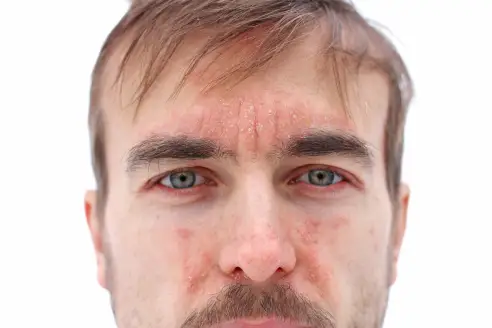Psoriasis can pop up anywhere you have skin—and we do mean anywhere, including around and inside your nose. It’s rare but it happens, and it can be incredibly uncomfortable (we’re talking redness, scaling, and itchy patches around or in the interior of your nostrils). But if you’re dealing with nasal psoriasis, there’s good news: There are ways to treat it so that you can get it under control.
What Is Nasal Psoriasis?
Nasal psoriasis is when the symptoms of psoriasis—the chronic condition in which an overgrowth of skin cells builds up into itchy, scaly plaques—pop up in and around the nose. According to the Psoriasis and Psoriatic Arthritis Alliance, it’s uncommon, but it does happen. And if you’re someone living with nasal psoriasis, it’s very likely that you have plaques other places as well. According to research in the journal Reumatologia, facial psoriasis (which includes psoriasis on the nose) is associated with longer disease duration and more severe cases, and it’s more common in people with scalp psoriasis. As for what brings it on? It’s the same common triggers, including stress, friction, and dryness, that flare up body psoriasis.
Can Psoriasis Occur Inside the Nose?
Yes, psoriasis can pop up anywhere you have skin, including what may seem like odd areas, including your palms, genitals, or inside your nose. This is especially true come cold and allergy season when friction from frequent nose-blowing can trigger a flare. While there’s nothing particularly dangerous about it, the simple fact is that psoriasis in your nose can be uncomfortable, as the area there is tender. So, if you’ve got psoriasis and you notice the symptoms spread to your nose, you’re likely thinking about it a lot.
What Does Nasal Psoriasis Look Like?
“Nasal psoriasis appears as small patches on the nose, which vary in color depending on the individual’s skin tone,” says Dendy Engelman, M.D., a board-certified dermatologist and dermatologic surgeon at the Shafer Clinic in New York City. “On lighter skin tones, nasal psoriasis usually appears as gray or white patches; on medium skin tones, the patches can appear pinkish with silvery-looking scales; on deeper skin tones, the lesions usually appear violet with gray scales.” As is always the case with psoriasis plaques, those patches are often itchy, though it may not look as hard, dry, or flaky as psoriasis in other areas, especially if mucus from a runny nose is covering it. Likely, you’ll recognize the symptoms from having psoriasis in other areas, but to the untrained eye it can be mistaken for cold sores, nasal vestibulitis (a bacterial infection inside your nostrils), or eczema.
How Is Nasal Psoriasis Diagnosed?
Nasal psoriasis is diagnosed just like psoriasis that occurs on other parts of the body. Usually, a diagnosis comes via a quick trip to your dermatologist or primary care physician for a visual examination and some questions. “Psoriasis is usually identifiable by appearance, description of symptoms, and analysis of the patient’s medical or family history,” says Dr. Engelman.
Sign up for our bi-monthly Psoriasis Newsletter.
Your privacy is important to us.
However, there are some cases in which a doctor may want to do a biopsy, particularly when the symptoms are unusual or hard to distinguish from other conditions. “Psoriasis may be confused with other inflammatory skin conditions such as atopic dermatitis or others, and a skin biopsy will allow a pathologist to make a definitive diagnosis by examining the skin on a microscopic level and looking for telltale patterns,” explains Rebecca Marcus, M.D., a board-certified dermatologist who specializes in medical, surgical, and cosmetic dermatology in Dallas, TX.
Conditions That Share Symptoms With Nasal Psoriasis
Psoriasis of the nose can be mistaken for several other conditions. Here are some of the most common, says Dr. Engelman:
Cold sores: According to the Mayo Clinic, while you may think of cold sores happening on the mouth, they can also pop up in and around the nose. Caused by herpes simplex virus type 1, they present as blisters that may ooze and crust over. And because they can itch, these sores can present like nasal psoriasis.
Nasal vestibulitis: This is a bacterial infection inside the nostrils that causes crusting and sores. “To those who are not familiar with this infection and its symptoms—the inflammation and crusts—nasal vestibulitis may look similar to nasal psoriasis,” says Dr. Engelman.
Eczema (a.k.a. atopic dermatitis): “Similar to psoriasis, eczema manifests as an inflamed rash with scaly patches,” says Dr. Engelman. However, the difference between psoriasis and eczema is that psoriasis presents as raised plaques, whereas eczema patches are thinner with less defined borders of affected skin, according to the National Psoriasis Foundation.
Nasal Psoriasis Medications
Advancements in dermatology and immunology have led to various treatment options designed to alleviate nasal psoriasis. From topical corticosteroids targeting inflammation to systemic medications addressing underlying immune system dysregulation, here are the treatment options for psoriasis that you’re likely to explore with your doctor:
Topical Treatments
Topical steroids and vitamin D ointments are often prescribed for psoriasis, but in nasal psoriasis, they may be prescribed with a side of antifungal and antibacterial medication, says Dr. Marcus. “In the moist environment of the nasal passages, bacteria and fungus may be more likely to grow on skin whose barrier is already compromised,” she notes. While retinoids and coal tar are often recommended for psoriasis, you should skip it for flares above the neck. “These ingredients can be too irritating for the skin on the face,” says Dr. Engelman.
Phototherapy
UV exposure (also known as phototherapy) has been shown to help quell psoriasis symptoms by helping calm inflammation. That means your doctor may recommend it to reduce your symptoms in general (including your nose), especially if your nasal psoriasis is on the outer area of your nose where the rays can reach.
Oral Medications
In some cases, oral medicines that reduce inflammation or curb skin cell production like methotrexate and cyclosporine may be prescribed. But it’s important to note that they come with the risk of side effects like nausea and high blood pressure.
Biologics
While biologics like Humira (adalimumab) and Enbrel (etanercept) are systemic medications that are often very effective, they’re not usually a first stop for psoriasis. Dr. Marcus points out that “they are also associated with a higher risk of side effects; therefore, most are reserved for moderate to severe cases of psoriasis that have not responded to other treatments.”
Home Remedies for Nasal Psoriasis
Your number one way to avoid getting a psoriasis flare of the nose: Keep your sinuses healthy, since sinuses that are too dry or too moist can lead to irritation. That means doing what you can to avoid getting sick and keeping your allergies in check with medications. But even the most cautious of people gets the sniffles from time to time. If that happens, here’s what to do:
Choose a Gentle Cleanser
It’s been accepted in the medical community for years that choosing a gentle cleanser is important for those with psoriasis, whose skin barrier is already compromised. Now, the latest recommendations take it one step further by naming specific culprits to avoid: A 2023 literature review in the Journal of Drugs in Dermatology concluded that a cleanser lacking harsh ingredients like fragrance and sulfates should be incorporated into all psoriasis care routines, but especially on the face.
Look for a Soothing Moisturizer
Keeping the skin around your nose (and the rest of you!) moisturized is a key part of psoriasis care. “Look for moisturizers with anti-inflammatory ingredients, such as green tea, aloe vera, witch hazel, ceramides, and niacinamide,” Dr. Engelman advises. “These ingredients will soothe the skin barrier and help calm psoriasis flare-ups.”
Use a Breathable Mask
If you’re choosing to mask up to avoid Covid-19 or other infections, using one that gives your nose room to breathe (so to speak) is a good idea. “[When it comes to psoriasis], avoid covering the affected area with tight fabrics or coverings that can trap in heat,” says Dr. Engelman. This can cause friction and irritation on the skin, which can lead to flares.
Use Soft Tissues
When it’s time to blow your nose, the type of tissue you choose is important when you’re dealing with psoriasis. Using tissues infused with soothing and lubricating oils can help prevent the friction that may bring on a psoriasis flare in your nose.
When to See a Doctor for Nasal Psoriasis
Anytime you suspect you may be having an issue with your skin is a good time to see your dermatologist. When it comes to psoriasis, if you’ve had a history of the condition and you notice your symptoms spread in or around your nose, a doctor can help address flares early and prevent them from turning into large-scale episodes!
The Takeaway
Finding psoriasis in or around your nose is rare, which means if you don’t have symptoms in that area, there’s no reason to start stressing out that it may magically appear. But if nasal psoriasis happens to crop up—or you’re already dealing with it—taking a look at the tissues you’re using, slathering on some moisturizer, and seeing a doctor for a remedy that’s right for you can go a long way to keeping you comfortable.





